Are they really hosting the US Open at Torrey Pines? Apparently so; there can’t be a more polarizing US Open site in the history of the Championship. As a start let me ask you what do Nicklaus, Watson, Miller, Woods, Weiskopf, Palmer, Mickelson, Love, Olazabal, O’Meara, Tway, Zoeller, Stadler and Daly have in common, other than the fact that they have all won a Major? Well they have all won at Torrey Pines also. Why would a golf course that identifies such great players be so castigated by the gca crowd for holding a US Open? Well, certainly because it has never been regarded as a great course. Tom Doak gave the original version a 3 in The Confidential Guide. Recent revisions by The Open Doctor himself, Rees Jones, have only elevated the course to the 12th best in the whole state of California places you can play rank per the latest Golfweek ratings. It doesn't even crack the top 30 in the State of Cal. per Golf Digest.
Many factors contribute this phenomenon. The site of the golf course was previously used by the US Army for Camp Callin during WWII. Surely the military eliminated any interesting micro undulations from the site to suit their needs. During a recent installation of the waste water irrigation system it was apparent that the site is composed of unfriendly soils; red clay and decomposed granite that were capped with 6 inches of top soil. Any attempts to recontour the fairways in the redesign would have been complicated; the top soil would need to be stripped away before the recontouring and then redistributed at an even layer.
Consider also that the entire redesign project had to be completed in less than 3 months. Using the 3.5 million dollars raised by the “Friends of Torrey Pines” the project started right after the prestigious Junior World Championship was held in early September of 2000. The entire redesign was completed in 91 days, the golf course was given the month of January to grow in and the Buick Invitational was contested in early February of 2001; a very ambitious plan indeed. Certainly there was limited time to attend to the fine tuning and attention to detail that is so evident in the finest courses of the world. However the project obviously met the criterion of its planners; turn a long but mundane track into a course worthy of holding the US Open. The parameters of the redesign meshed perfectly with the wants of the USGA; 7600 yards of length, to force an occasional mid iron into the hands of the world’s best players. The greens, which are all composed of 3 flat sections which can accommodate the anticipated the 13 stimp meter readings, are separated by ridges creating small targets for the contestants. The greenside bunkers were all deepened; seemingly a must requirement to host an Open in the 21st Century; see Oakmont and Merion. There is no question that the new Torrey Pines South is a hard golf course.
The detractors have some valid points. Other than the small dip in front of the par 4 2cnd and the large swale on the par 5 13th, there is very little elevation change within the golf course; as you will see from the pictures, the golf course does not photograph well from ground level. The pictures in the recent USGA Open magazine all appear to be taken from a ladder or cherry picker to provide some prospective. Other than the 6th and 7th, which dogleg around a canyon, the holes are all dead straight.
The run up to the Open has brought several changes. The par 5 6th hole will be played as a 500 yard par 4. Trees along the canyon edge were cleared and an additional bunker was placed in the string of 3 that were on the outside edge of the dogleg. A new tee was added at the par 5 13th that will stretch the hole to 613 yards; requiring a 240 yard carry over the canyon. A year long project was undertaken during 2007 to increase the percentage and quality of the Kikuyu grass with the fairways. The water was turned off and carts were relegated to the new continuous cart path. The fairways are now almost completely Kikuyu and provide an excellent surface to play off. The greens were allowed to be infested with Poa Annua, replacing the A-4 Bent that refused to thrive in the cool coastal climate. The rough has been over seeded with Rye and is 5 inches in depth. When 18 new greens were built it was necessary to then tie them in to the existing fairways. This was done with a Bermuda, Rye combination. It is now possible to run the ball onto every green because not only are they all unprotected in the front by bunkers, but the grassing scheme will allow the ball to bounce forward; you would be unable to accomplish this with a Kikuyu approach.
And now, on to the course. These photos were taken on May 16, 4 days before the course was closed to prepare for the Open. Here are the Wardian statistics, from the back tees the scorecard says: par 72, 7628 yards, slope 143 and CR 78.1 (you can add the 74 extra yards from the new tee on 13 to come to 7701; still not long enough to put long irons into the players hands or keep them off the par 5’s in 2).
#1 par 4 450 yards Here is the view many will see on a cool spring morning; fog and or marine layer are certainly likely;
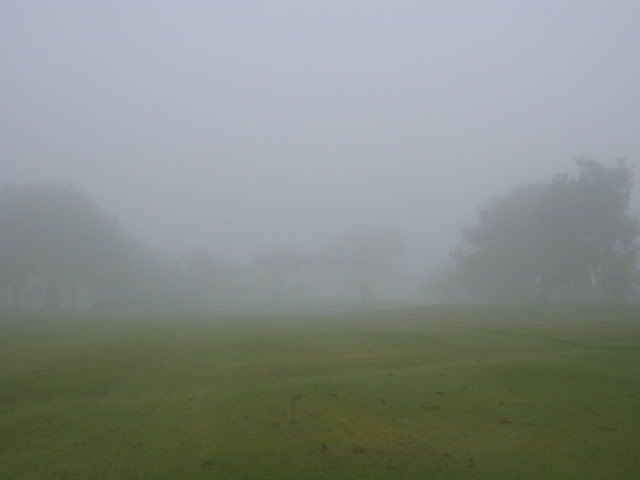
Here is a view from the tee taken last summer during the Kikuyu improvement program:
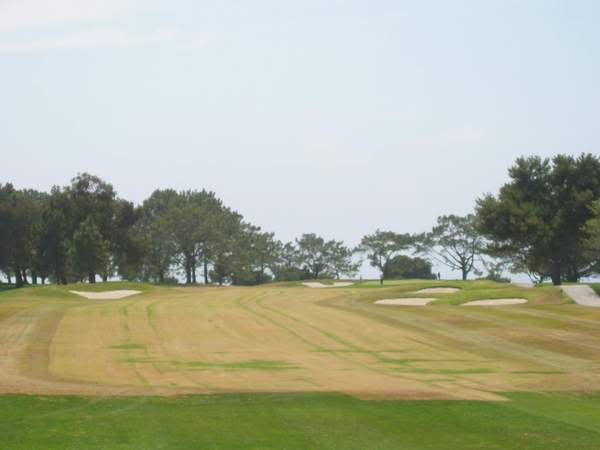
And the second shot from the ideal landing area.
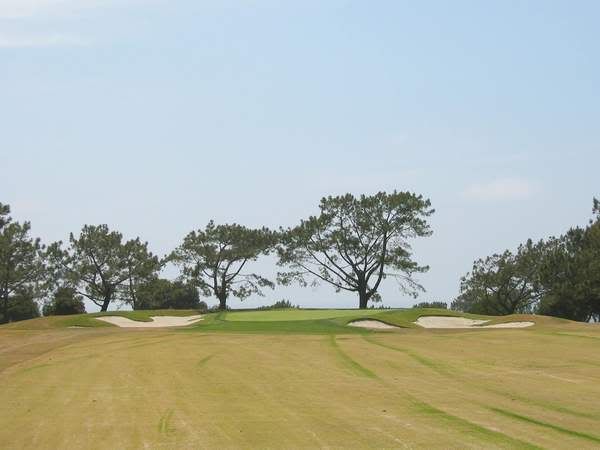
#2 is the shortest par 4 on the course at 389 yards; Rees built a 30 yard long bunker to guard the left side.
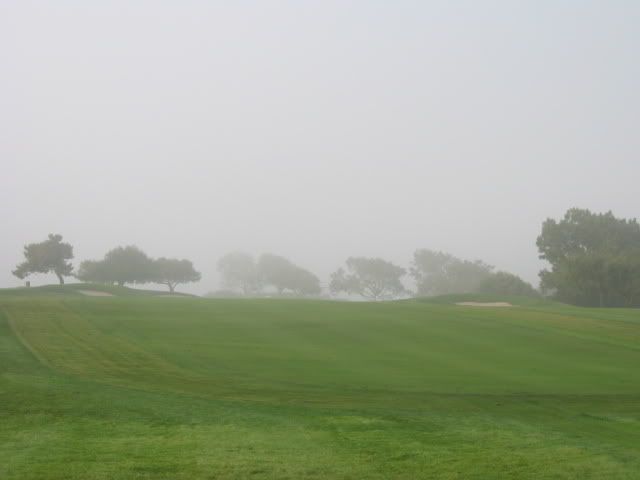
The view to the green shows the large swale just before it. This is the green with the most front to back slope on the course:
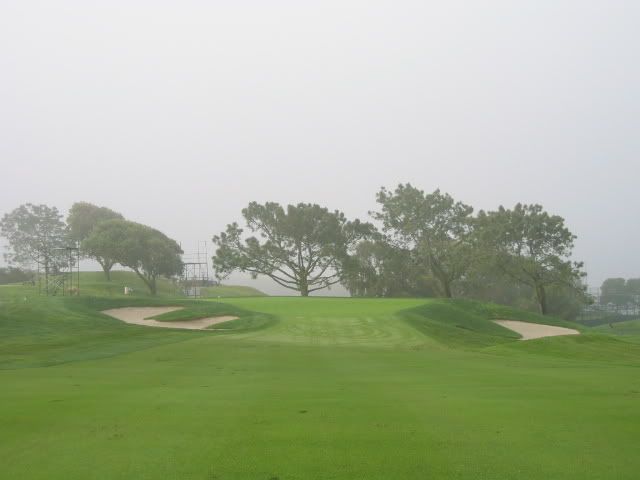
This is the shot from the 200 yard tee to #3. The hole was vastly improved by moving the green 30 yards to the left to bring the canyon into play. The green and accompanying bunker are functional but utterly bereft of visual charm:
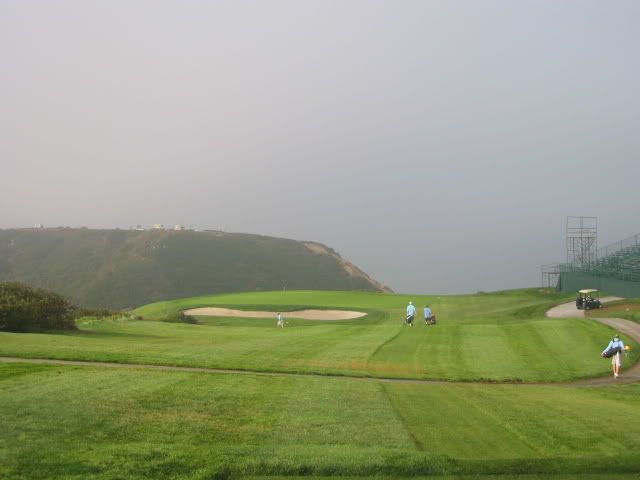
This is the completely different angle from the 145 yard tee which is promised to be used for the most difficult hole locations:
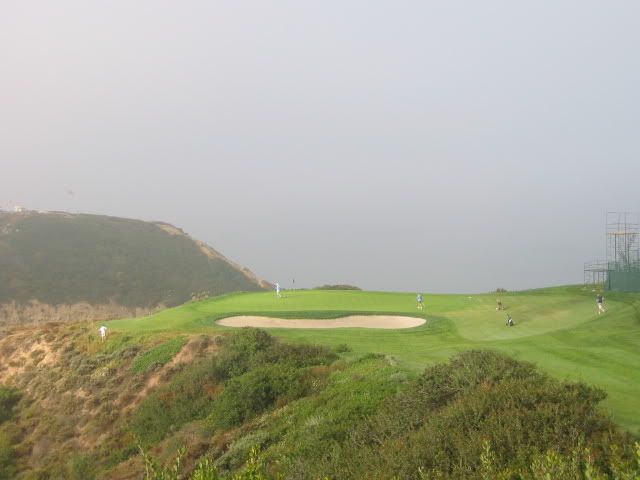
The 488 yard par 4 4th:
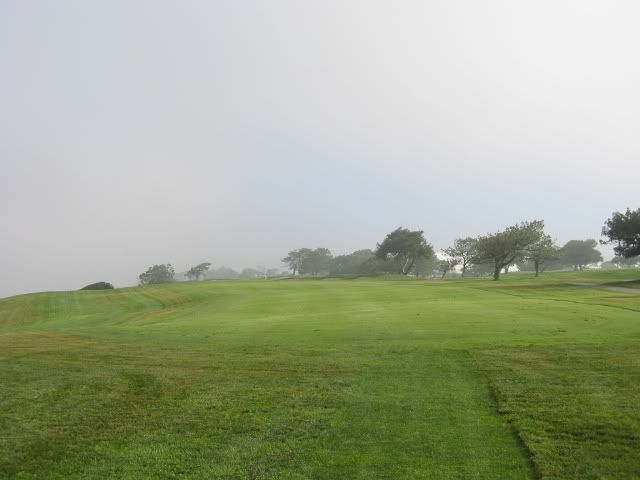
These Torrey Pines were transplanted from the left side of the fairway to the right to, in Director of Golf Mark Woodward’s terms, “make a true seaside hole”. They also block players from driving to the 5th fairway for a better angle to the difficult left pin position:
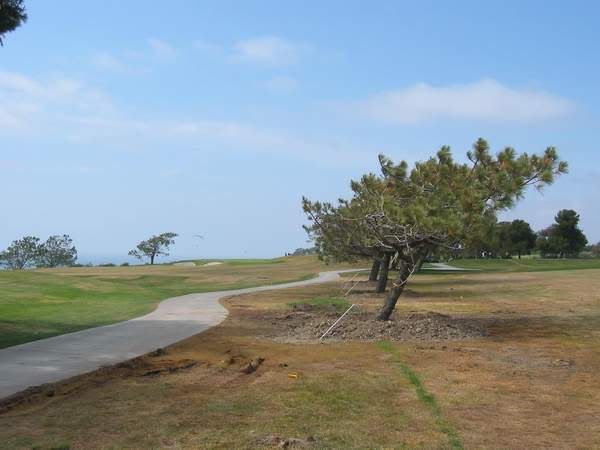
The shot into the green.
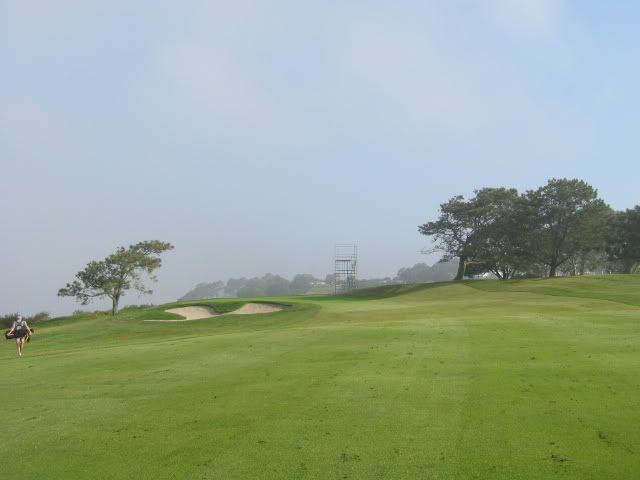
This bank was recently mown to fairway height to allow players to carrom their shots into the green:

The par 4 5th hole measures 454 yards and has probably the tightest landing area, as the two bunkers pinch the ideal tee shot in true “Jones, Open Doctor fashion”:
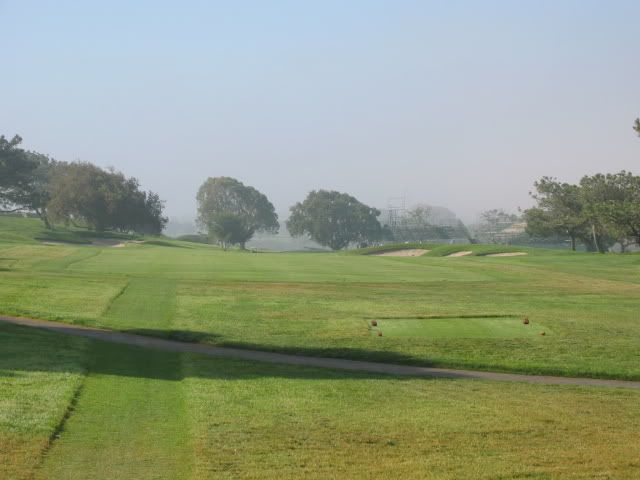
The shot into the green:

This is what the tee shot on #6 looked like before the Eucalyptus trees were removed from the edge of the canyon:
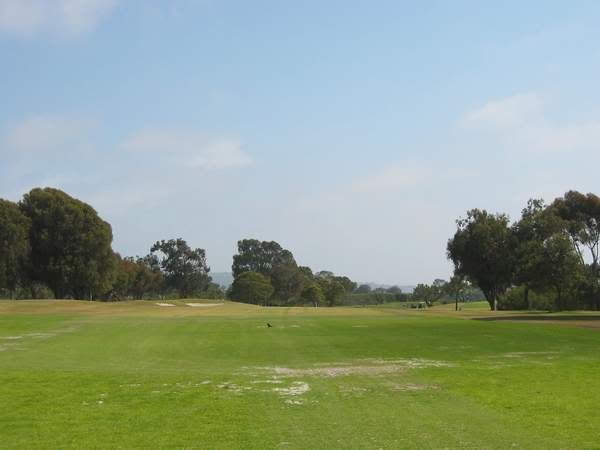
Now a solitary gum tree guards the right of this 500 yard converted par 4 hole:
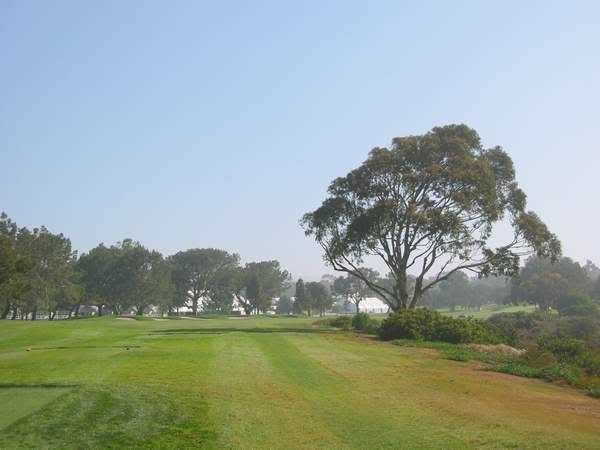
Here is the shot into the green:
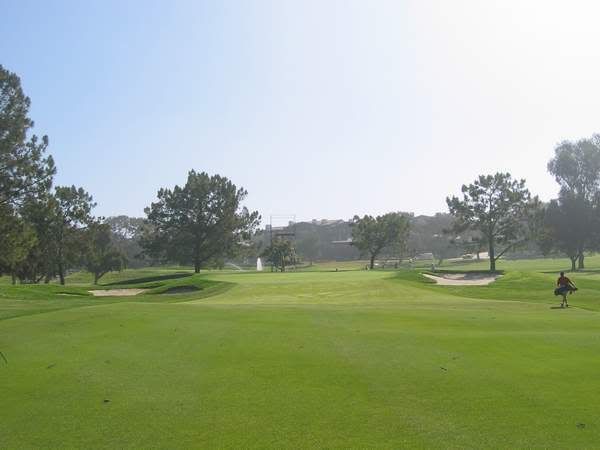
The par 4 7th hole doglegs around d the canyon and plays 462 yards:

Here is the shot into the green, one of the few holes to be bunkered on one side of the green only:
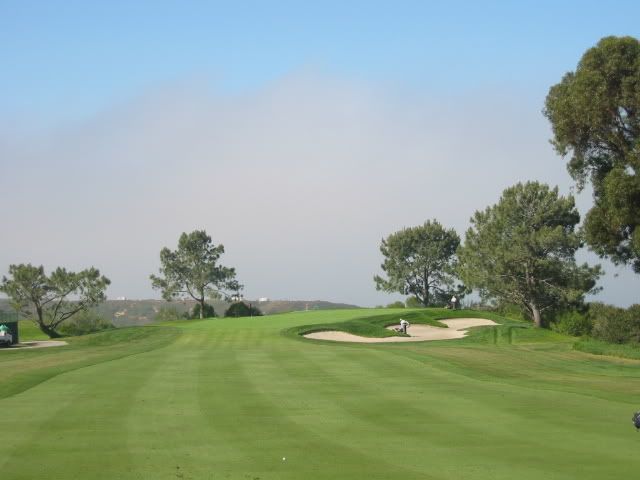
Here is a new chipping area that was just recently added:
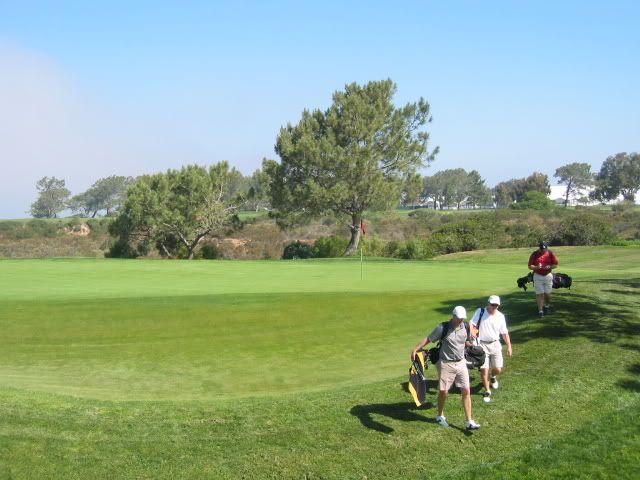
Here’s a big problem, 7 years after a 3,5 million dollar renovation bunkers are routinely flooded. Who’s to blame for this, the architect, maintenance staff or irrigation installers? I bet the 3 guys from Long Beach who paid $180 to play here didn’t appreceiate it. Several other bunkers were saturated as well; just unacceptable.
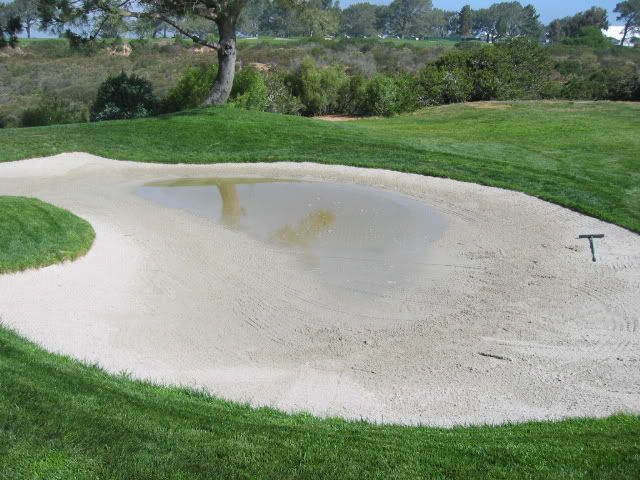
The shortest hole on the course is the par 3 8th at 176 yards. The green is very shallow with a deep bunker in front and another bunker directly behind the green:

Here’s look from behind the green, showing the uphill nature of the shot:
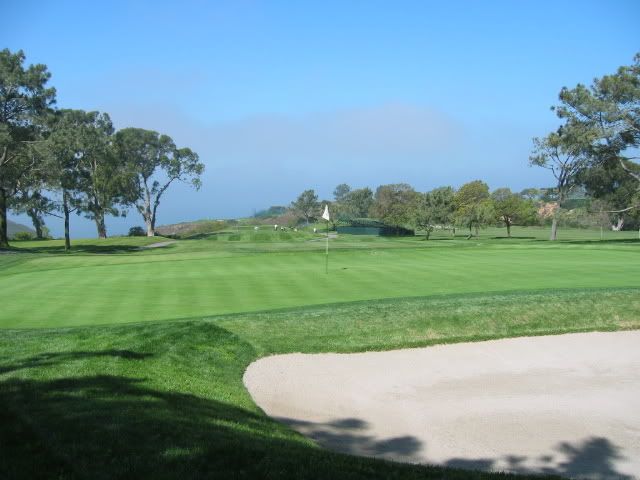
A massive elevated back tee was built in the redesign to stretch the 9th to 614 yards:

Here’s the shot into the green:
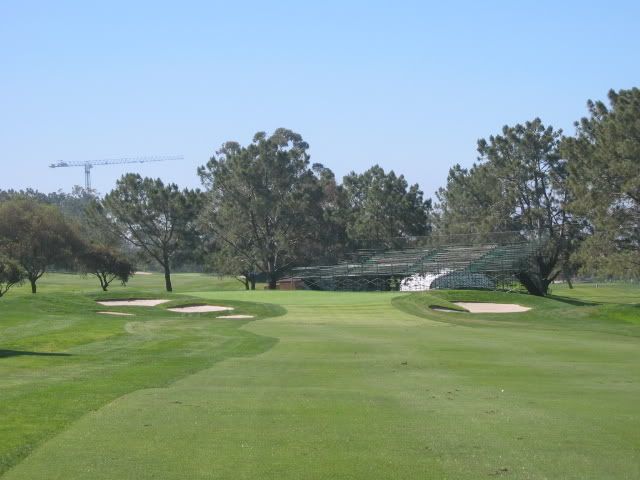
The 10th represents the last breather hole; at 416 yards it will be 3 wood, wedge for most:
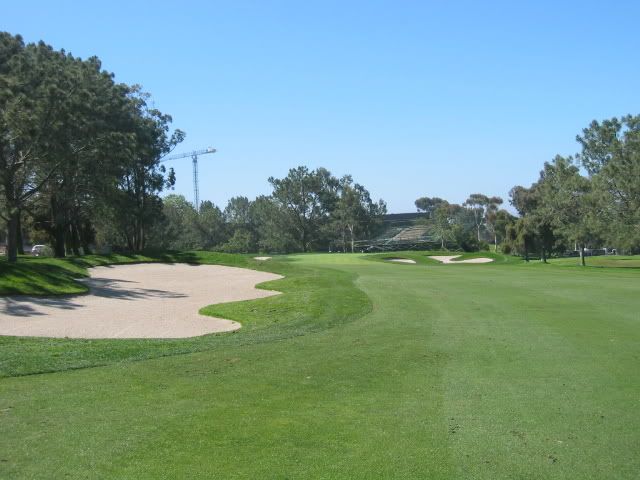
The green has a pronounced left to right slope towards the sea:
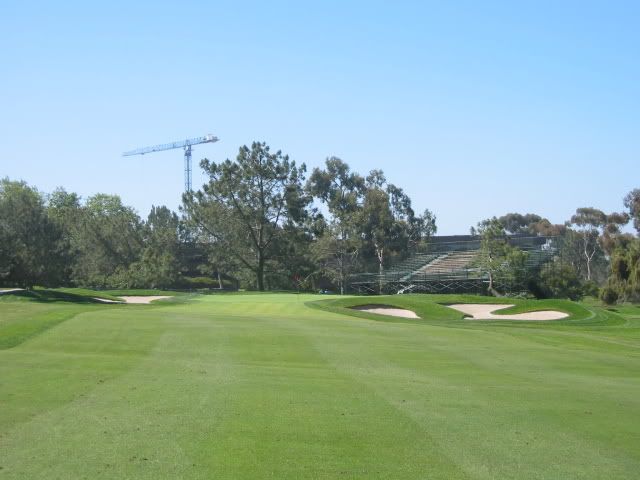
The par 3 11th will play 221 yards; even the slightest bearing error will cause a missed green and a tough up and down:
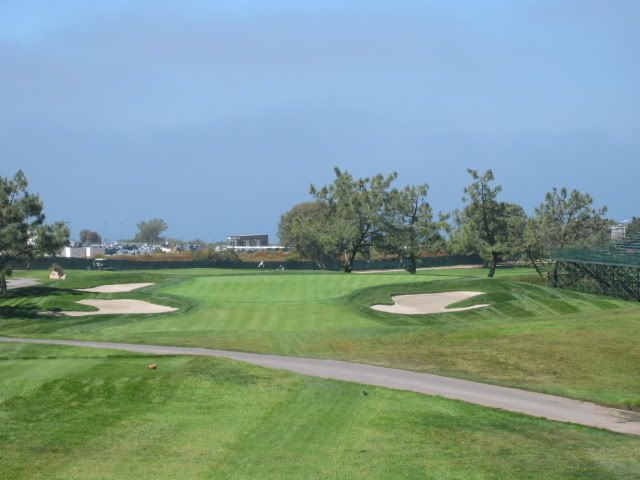
Before the redesign the 12th played 460 yards into the prevailing wind, the toughest par 4 I had ever played. It now plays 504 yards; I bet Tiger will hit less than 6 iron here:
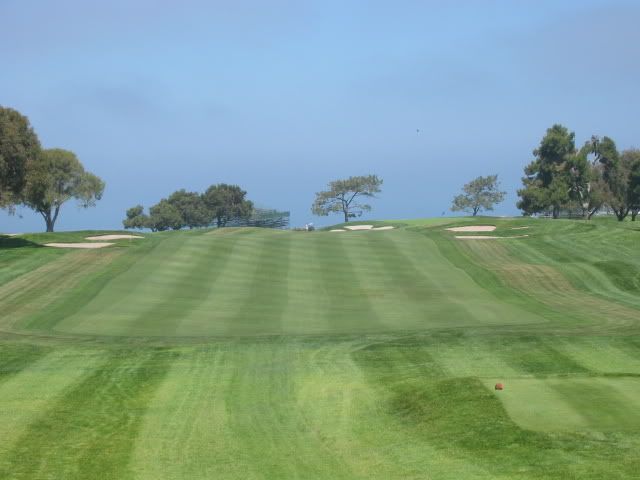
The second shot; the glider port is just to the left of this green, you’ll usually see parasailers in the background:

Here is the tee shot on the par 5 13th from the normal 540 yard tee; a simple driver, 5 iron for Tiger:
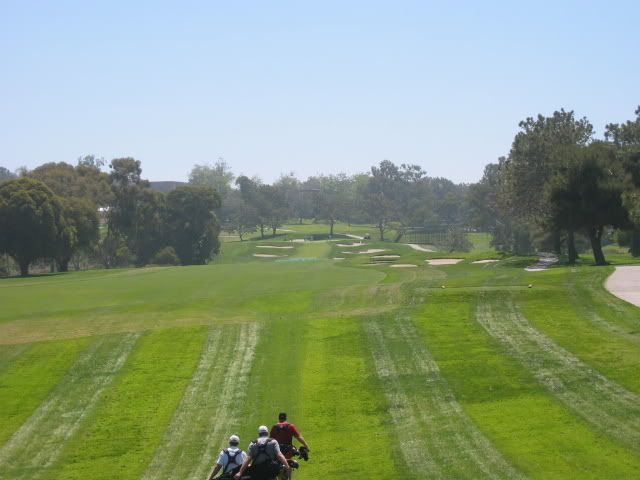
Here is the view from the new tee which is back and to the left of the original. It requires a 240 yard carry to clear the canyon. When we played from here last summer you couldn’t bail out right because of the tree you can see in the right of the frame. We weren’t able to go there in May, so I can’t say if they have done something to allow a bailout right:
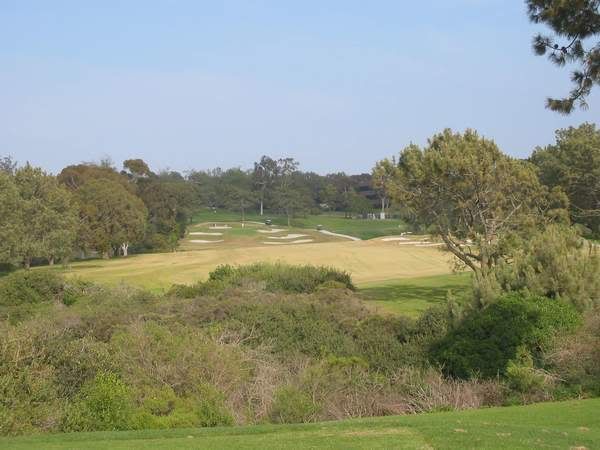
The view into the green. There is a large gully and a small terrace (covered in mesh) which is the ideal lay up area, giving the player 100 yards to the green. Although the "Stairway to Heaven" bunkering scheme is visually jarring, it does produce one of golf's toughest shots: the blind 40 yard uphill bunker shot:
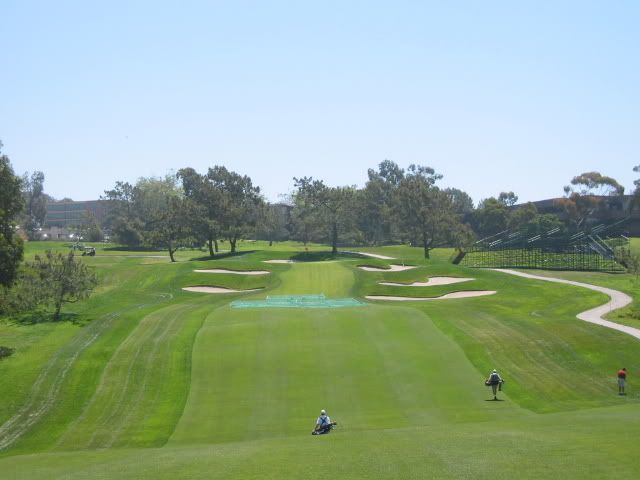
Rees is very proud of this hole and rightly so. Moving the green 30 yards left to the canyon edge makes it truly special. The gull winged double plateau green actually works well on this hole, both visually and strategically. The normal yardage is 437; yes that tee with red marker is where they will play it on Sunday, a mere 277 yards:

From this shot you can see that it will be possible to run one onto the putting surface; hopefully the approach will be conditioned properly to accept that shot. I hit a low drawing hybrid that died as it tried to run on; the course was overly wet that day:
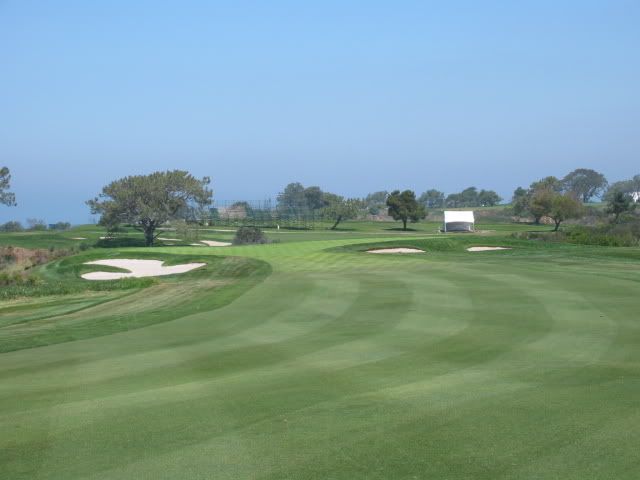
The 15th calls for a 100 yard walk backwards to reach the 478yard tee. It has the narrowest landing area on the course. This hole was the scene of one of the most amazing golf shot ever hit when Tiger hit a 4 iron from the right rough under a tree and stiff to the pin from over 200 yards out; David Feherty needed Kleenex after witnessing that shot:
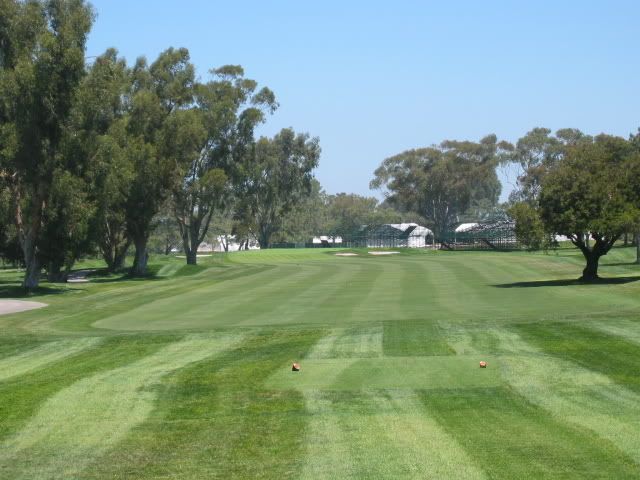
The green has a pronounced right to left slope, with a chipping area short left. The back right hole location looks as though the flag can’t actually be on the green:
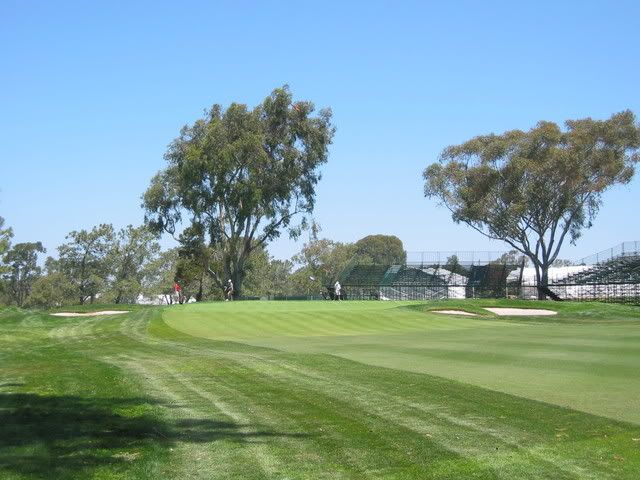
Here is a new tee that has never been used on #16. From here the two left front bunkers will be brought more in play; it will play about 190 yards from here:
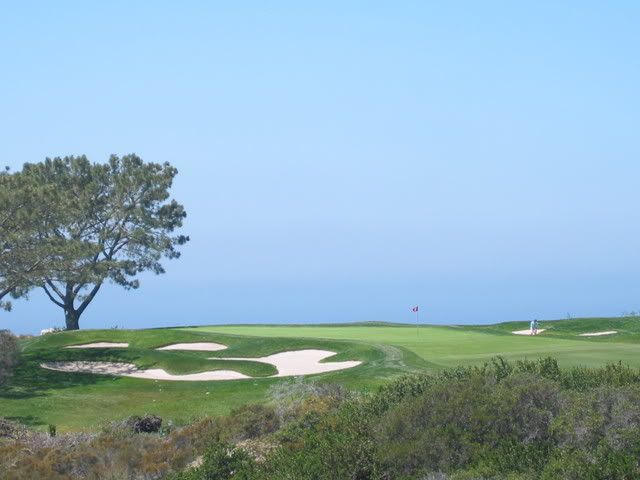
The normal tee makes the hole 227 yards. Two large Torrey Pines were removed from the back of the green to give it a nice skyline effect and keep from blocking out the prevailing wind:
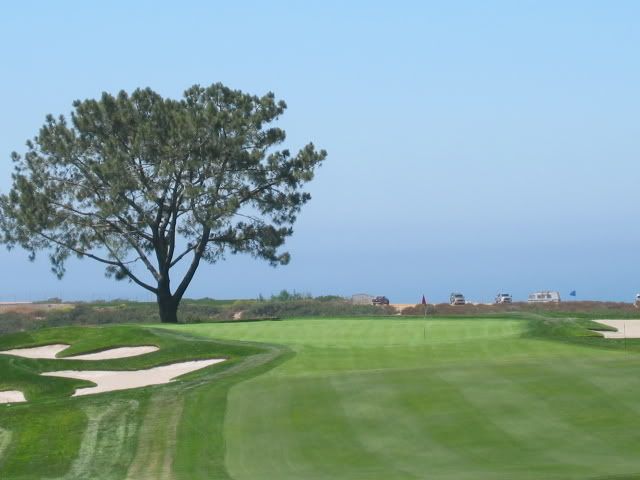
Everyone will remember the 17th for the famous incident in the Phil Mickelson and Frank Lichlighter playoff. The canyons are normally staked as lateral water hazards for public play. All red stakes have been removed for the Open and the canyons will be a stroke and distance penalty. The hole plays 442 yards:
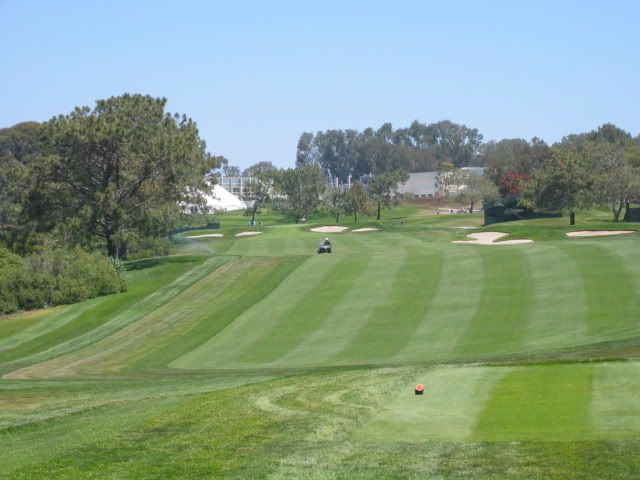
The green is the most elevated on the course:
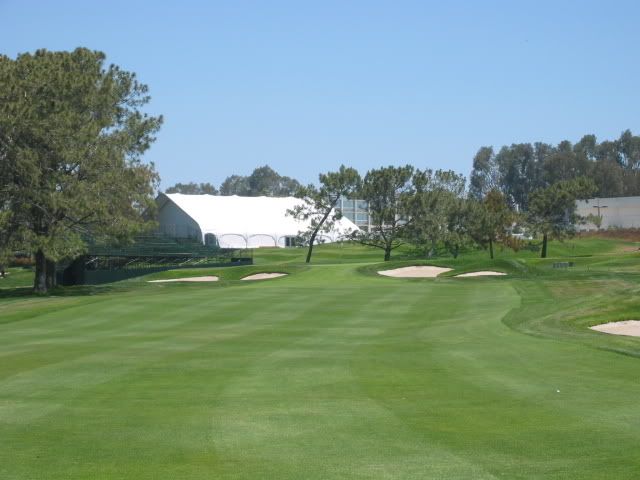
The 18th will play as a par 5; the back tee makes it play 570 yards:
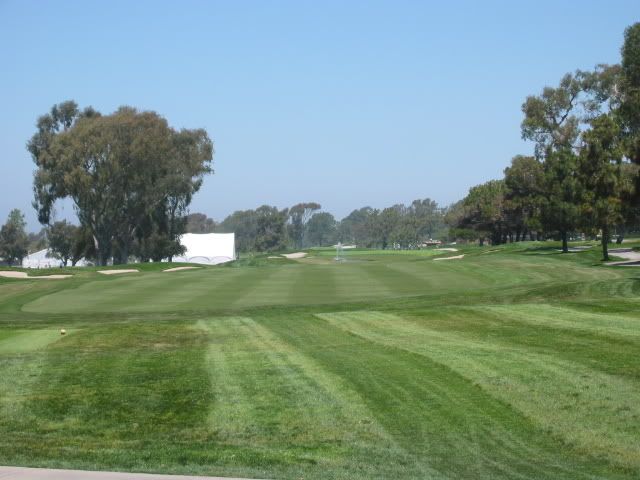
Here is the shot into the green; lay ups just short of Devlin’s billabong will yield a 70 yard L wedge shot. I guess they didn’t get the memo to turn off the damned fountain:
